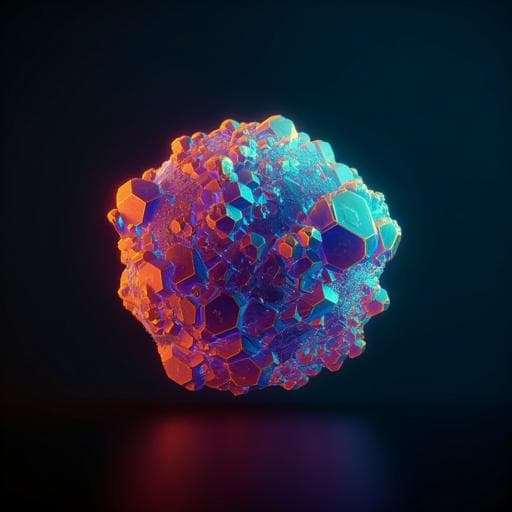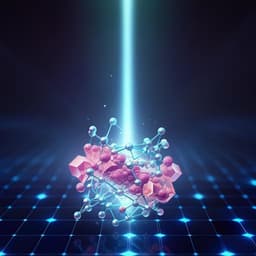
Engineering and Technology
Engineering fluorinated-cation containing inverted perovskite solar cells with an efficiency of >21% and improved stability towards humidity
X. Wang, K. Rakstys, et al.
Discover how a small addition of fluorinated lead salt can transform three-dimensional methylammonium lead iodide perovskite into high-efficiency solar cells with remarkable stability. This groundbreaking research showcases a maximum power conversion efficiency of 21.1% while enhancing hydrophobicity and crystal quality. The work is led by a team from the Centre for Organic Photonics & Electronics at The University of Queensland.
~3 min • Beginner • English
Introduction
The study addresses how to achieve efficient, stable perovskite solar cells with simple active layers suitable for manufacturing, focusing on inverted (p-i-n) architectures. While 3D hybrid perovskites can reach very high efficiencies, environmental stability (moisture, heat, light) remains a barrier. Incorporating large ammonium salts to form 2D or mixed 2D/3D perovskites improves stability but can reduce efficiency due to quantum confinement, reduced mobility, and narrower absorption. Mixed 2D/3D systems are proposed to combine stability and performance, but terminology and structural verification are often inconsistent. Prior efforts with large cations like n-butylammonium and phenylethylammonium show improved stability with up to ~20% PCE, and fluorinated spacers have yielded high efficiencies in n-i-p devices, sometimes with antireflection coatings. Inverted devices have lagged, though a recent complex multicomponent inverted system with a fluorinated ammonium cation achieved ~21% PCE with antireflection. This work explores whether a simple addition of a fluorinated spacer salt to a 3D MAPbI3 precursor can deliver high-efficiency, stable inverted devices without forming a bulk 2D phase.
Literature Review
- 3D perovskites achieve high efficiencies (certified up to 25.2%) but often rely on complex multi-cation/anion mixtures and face stability challenges.
- 2D Ruddlesden–Popper perovskites ((RNH3)2(An−1BnX3n+1)) offer improved moisture and thermal stability via hydrophobic spacer cations, with inverted device PCEs reported up to ~18.2%.
- Mixed 2D/3D materials aim to balance stability and performance, yet the existence and nature of 2D/3D structures can be ambiguous and highly dependent on the large cation used. Widely studied spacers include n-butylammonium and phenylethylammonium (PEA), with devices reaching up to ~20% PCE.
- Additional spacers such as 5-ammoniumvaleric acid iodide (n-i-p, PCE 14.6%) and 2,2-(ethylenedioxy)bis(ethylammonium) based systems (n-i-p, steady-state 19.7%) have shown enhanced stabilities. Thiophenemethylammonium in FA/MA-based 3D perovskites reached 21.5% (n-i-p).
- Fluorinated spacer cations have been applied in n-i-p 2D/3D systems for hydrophobicity and stability, with a bilayer 3D/2D fluoroarene system achieving 22.1% with antireflection coating. A complex inverted multicomponent perovskite including a fluorinated ammonium reached 21.1% PCE (with antireflection), but the additive location and concentration range were unclear.
- Inverted (p-i-n) perovskites can be advantageous for low-temperature processing, reduced hysteresis, and UV stability, though reports of efficient 2D/3D inverted cells are fewer and often lower in PCE than n-i-p counterparts.
Methodology
- Active layer preparation: MAPbI3 perovskite films prepared from precursor solutions in GBL:DMSO (7:3 v/v), 1.2 M PbI2 and MAI. FEAI (2-(2,3,4,5,6-pentafluorophenyl)ethylammonium iodide) synthesized per literature, partially replacing MAI to achieve targeted (FEA)2PbI4 mol% in precursor (e.g., 0.3 mol%: 2.2 mg FEAI, 171.2 mg MAI, 497.9 mg PbI2 in 0.9 mL solvent). Films spin-coated via two-step process (1000 rpm 10 s; 5000 rpm 80 s) with toluene antisolvent drop at 15 s during second step, then annealed at 100 °C for 30 min in N2 glovebox.
- Device architecture: Inverted structure ITO/PTAA/PFN-P2/perovskite/C60/BCP/Cu. PTAA (2.5 mg/mL in toluene) spin-coated 6000 rpm 30 s, baked 100 °C 10 min; PFN-P2 (0.5 mg/mL in methanol) spin-coated 5000 rpm 20 s to assist wetting. C60 (20 nm) and BCP (7.5 nm) thermally evaporated; Cu cathode (100 nm) deposited. Active area 0.071 cm2. All steps except ITO cleaning performed under inert conditions.
- Photovoltaic characterization: J–V measured under AM 1.5G (~100 mW/cm2) with Keithley 2400, scan rate 200 mV/s, in glovebox. Solar simulator calibrated with NREL-certified Si photodiode with KG5 filter; mismatch factor 1.09 applied. EQE measured with PV Measurements QEX7; integrated Jsc cross-checked.
- Optical and structural characterization: UV–vis absorption (Cary 5000); steady-state PL (Horiba Fluoromax, 450 nm excitation); TRPL (Fluorolog-3 TCSPC, 441 nm LED, detection at 767 nm); temperature-dependent PL (77–293 K, 550 nm excitation). Thickness by profilometry. GI-WAXS and GIXRD: Rigaku Smartlab out-of-plane GI-XRD at 0.3°, and 2D WAXS on Xenocs Xeuss 2.0 at incident angles 0.14° and 0.3°. SEM on fractured cross-sections. XPS depth profiling (Kratos Axis Ultra, Al Kα; Ar ion etch ~50 nm per 3 min step) for F distribution. AFM and SKPM (Pt-coated cantilever) for surface morphology and work function. Water contact angle measurements on films atop glass/ITO/PTAA/PFN-P2.
- Stability testing: Unencapsulated devices stored in dark at 85 °C in N2 for thermal stability; and in dark in air at 80 ±10% RH at RT for humidity stability; periodic J–V measurements. Maximum power point tracking under simulated AM 1.5G illumination performed to assess operational stability.
Key Findings
- Performance optimization: Adding (FEA)2PbI4 to MAPbI3 increased Voc with increasing mol% but reduced Jsc and FF at higher contents. Optimal at 0.3 mol% (FEA)2PbI4 with champion PCE 21.1%, Voc 1.12 V, Jsc 22.4 mA/cm2, FF 84%, and negligible hysteresis. Neat MAPbI3 reference reached PCE 19.1% (Voc 1.07 V, Jsc 22.3 mA/cm2, FF 79%). Over >30 devices each, average PCE improved from 18.3% (MAPbI3) to 19.5% (0.3 mol%). Highest Voc observed was 1.16 V at 5 mol%, but with lower Jsc/FF leading to lower PCE.
- Optical properties: Absorption spectra for films up to 10 mol% (FEA)2PbI4 matched MAPbI3 (onset ~760 nm), indicating absence of substantial low-n 2D phases; 50 mol% exhibited excitonic peaks (~403, 499, 547, 569 nm) from 2D phases (n=1–4). PL blue shift characteristic of mixed 2D/3D appears only >10 mol%; 10 mol% shows slight blue shift; 50 mol% significant shift with emission <600 nm from small-n 2D phases. PL intensity and lifetimes increased with higher (FEA)2PbI4, consistent with defect passivation and/or exciton confinement. Temperature-dependent PL showed FEAI suppresses the MAPbI3 tetragonal-to-orthorhombic phase transition temperature; at 77 K, tetragonal emission persists with 0.3–3 mol% addition.
- Structure and composition: GI-WAXS/GIXRD indicated films up to 10 mol% comprise MAPbI3 crystals, with no clear 2D RP phase peaks; surface-sensitive measurements showed larger, more textured surface crystallites with increasing (FEA)2PbI4, particularly in (110) plane alignment parallel to surface. High-resolution GI-XRD revealed diminishing PbI2 residual peak (~0.9 Å−1) with FEAI addition, disappearing at >1 mol%.
- Depth distribution: XPS depth profiling of 0.3 mol% film showed strong fluorine signal (19 atom%) within top ~50 nm and negligible (<0.7 atom%) in bulk, evidencing vertical phase separation with (FEA)2PbI4 concentrated at the film-air interface. Higher precursor mol% increased both surface F concentration and penetration depth of F. Similar vertical separation observed in formamidinium lead triiodide films, suggesting generality.
- Surface properties: SKPM/AFM showed increased work function with FEAI (e.g., from ~5.22 eV for MAPbI3 to ~5.34 eV at 0.3 mol%), and larger potential differences at grain boundaries, implying additive accumulation at boundaries. Contact angle increased from ~62.3° (MAPbI3) to ~90.5° (0.3 mol%), with further increases at higher mol%, indicating enhanced surface hydrophobicity.
- Stability: Thermal (85 °C, dark, N2): initial T80 ~55 h (MAPbI3) vs 183 h (0.3 mol%); long-term T50 ~1450 h (MAPbI3) vs 1550 h (0.3 mol%). Humidity (80 ±10% RH, dark, RT): T80 ~69 h (MAPbI3) vs 217 h (0.3 mol%); MAPbI3 T50 ~350 h; 0.3 mol% did not reach T50 within ~500 h. Degradation under heat mainly via FF; under humidity mainly via Jsc loss for MAPbI3. Under MPP illumination, MAPbI3 PCE dropped 35% in 7 h; 0.3 mol% dropped 22% in 10 h and to ~60% after 100 h, indicating slower burn-in and improved operational stability.
- Overall, small FEAI additions improve efficiency and stability without forming a detectable 2D phase throughout the film at low mol% by passivating surfaces/grain boundaries and inducing a hydrophobic, oriented, larger-crystallite surface layer.
Discussion
The findings demonstrate that incorporating a small amount (0.3 mol%) of FEAI into a MAPbI3 precursor for inverted (p-i-n) devices yields high efficiency and enhanced stability without creating a bulk 2D or mixed 2D/3D perovskite phase. Vertical phase separation concentrates the fluorinated species near the top surface/electron-extraction interface, passivating surface and grain-boundary defects (evidenced by increased PL intensity/lifetime and SKPM maps), increasing work function and hydrophobicity (larger contact angles), and promoting larger, more oriented surface crystallites. These interfacial and surface structural changes increase Voc and FF (at optimal low loading) and reduce hysteresis, while improving resistance to humidity and heat. At higher FEAI contents, despite further increases in Voc, Jsc and FF degrade—likely due to altered microstructure and possible exciton confinement—reducing overall PCE. The results resolve a common trade-off between stability and efficiency in 2D/3D approaches by showing that low-concentration fluorinated additives can deliver stability gains and record-level inverted device performance without requiring a defined 2D capping layer or mixed 2D/3D bulk structure. The approach appears general across at least MA- and FA-based iodide perovskites.
Conclusion
This work presents simple, low-temperature processed inverted MAPbI3 solar cells enhanced by a minimal addition (0.3 mol%) of FEAI, achieving a champion PCE of 21.1% without antireflection coating and exhibiting improved thermal and humidity stability. Structural, compositional, and photophysical analyses show no detectable 2D perovskite phase at low additive levels; instead, FEAI vertically segregates to the film surface and grain boundaries, increasing hydrophobicity, work function, and surface crystallite size/orientation while passivating defects. Performance decreases at higher FEAI loadings, emphasizing an optimal low concentration. Similar vertical segregation in FA-based perovskite indicates the strategy’s broader applicability. Future work could explore: (i) generalization across diverse perovskite compositions and architectures; (ii) controlled tuning of additive distribution and surface orientation; (iii) encapsulated and long-term operational stability under continuous illumination; and (iv) understanding interplay between additive concentration, microstructure, and charge transport to further optimize Jsc and FF.
Limitations
- Lack of detectable 2D RP diffraction features does not exclude the presence of very small or sparsely distributed 2D crystals; such phases could be below detection limits of GI-WAXS/GIXRD.
- SEM cross-sectional analysis was complicated by electrode delamination and increased beam-induced degradation at higher FEAI contents, potentially introducing artifacts.
- XPS depth profiling provides semi-quantitative depth information with finite etch-step resolution (~50 nm) and detection limits; evenly distributed low F levels (~0.4 atom% expected at 0.3 mol% if uniform) would be below detection.
- Stability tests were conducted on unencapsulated devices in the dark (thermal and humidity) and under laboratory illumination for MPP tracking; real-world, encapsulated operational stability was not assessed.
- The role of residual PbI2 in device performance and stability remains debated; while FEAI reduced detectable PbI2, its optimal presence/absence is not fully resolved.
- Performance trends are architecture- and process-specific (ITO/PTAA/PFN-P2/C60/BCP/Cu), and generalization to other stacks may require re-optimization.
Related Publications
Explore these studies to deepen your understanding of the subject.







